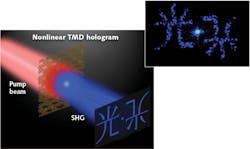Nanopatterned WS2 monolayers enable subnanometer-thick optical holograms
Scientists at Missouri University of Science and Technology (Rolla, MO) have created what they say are the thinnest optical holograms to date using only one tungsten disulfide (WS2) monolayer, itself only about 0.7 nm thick. Using focused-ion-beam milling, pre-designed hologram patterns with binary amplitude modulation of zero and one are directly etched into the WS2 monolayer—a transition metal dichalcogenide (TMD) material—that has been deposited on a sapphire substrate. By exciting the nanopatterned monolayer with a near-infrared ultrafast laser, the reconstructed holographic images in visible wavelengths are obtained in the transmitted signals through the same nonlinear optical process of second-harmonic generation that is also used to produce vortex and Airy beams and other complex images.
Not only do these TMD transmission holograms have high nonlinear conversion efficiencies on the order of 10-6 to 10-5 (much higher than that for the currently existing plasmonic metasurface holograms on the order of 10-11 to 10-9), but they also have an atomic thickness of less than 1 nm—far thinner than the tens of nanometers for plasmonic metasurfaces and hundreds of nanometers for dielectric metasurfaces. This new concept for fabricating atomically thin optical holograms with 2D material monolayers will enable new applications in 3D displays for smart watches, security markings on credit cards and banknotes, and even for high-density data storage. Reference: A. Dasgupta, J. Gao, and X. Yang, Nano Lett., 19, 9, 6511–6516 (Aug. 16, 2019).

Gail Overton | Senior Editor (2004-2020)
Gail has more than 30 years of engineering, marketing, product management, and editorial experience in the photonics and optical communications industry. Before joining the staff at Laser Focus World in 2004, she held many product management and product marketing roles in the fiber-optics industry, most notably at Hughes (El Segundo, CA), GTE Labs (Waltham, MA), Corning (Corning, NY), Photon Kinetics (Beaverton, OR), and Newport Corporation (Irvine, CA). During her marketing career, Gail published articles in WDM Solutions and Sensors magazine and traveled internationally to conduct product and sales training. Gail received her BS degree in physics, with an emphasis in optics, from San Diego State University in San Diego, CA in May 1986.
